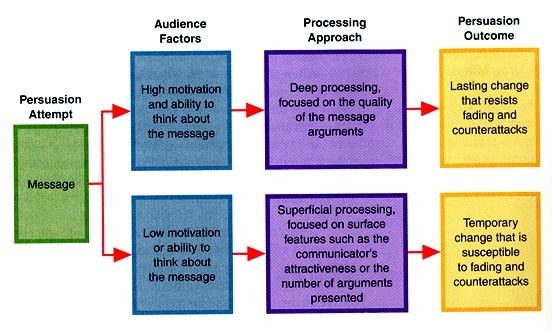Instructional Design And The Elaboration Likelihood Model
Health behavior theories are frequently used when designing interventions to improve individual health-related behaviors, but are often not used outside of that space. However, understanding the mechanisms by which individuals choose to exercise, eat healthy, and drink moderately can be applied to many different behaviors. As the goal for many eLearning products is to change behavior, considering the different theories of health behavior may help to facilitate sound Instructional Design.
In a previous article, I highlighted a popular health behavior theory, The Transtheoretical Model, and discussed how it might be applied to Instructional Design. This time around, I will be discussing the Elaboration Likelihood Model. Although the model was not originally developed within the health field, it has been used to explain the impact of health messaging with much success.
Elaboration Likelihood Model
Developed in the 1980’s by Petty and Cacioppo, the Elaboration Likelihood Model (ELM) is a “dual process theory” that seeks to explain how individuals process messages and change their attitudes. Essentially, they propose that people process information through two routes; either the central route or the peripheral route. The central route involves a high level of critical thinking and results in attitudes that are longer lasting, resistant to change, and are more likely to lead to behavior change. However, the central route requires mental energy, so individuals will only process messages through this route if they:
- Are motivated to think about the information.
- Have the cognitive ability to think about the information.
On the other hand, the peripheral route is taken by individuals who do not have the motivation or ability to process a message deeply, and instead rely on simple cues within the message to shape their attitudes. Cues could include who the speaker of the message may be. For example, advertisers of products that might not foster much deep thinking (like clothes, shampoos, etc.) often rely on attractive models in their ads as cues that could sway individuals who are using the peripheral route to process the message. However, attitudes that result from peripheral processing are weak and often do not lead to sustained behavior change. 
Image from http://bama.ua.edu/~sprentic/672%20outline-ELM.htm
Implications For Instructional Design
Now, what does this have to do with Instructional Design for eLearning? As many courses we develop will have a distal goal of behavior change, it is important to make sure that our audience is processing content in a way that will lead to strong attitudes and subsequent behavior change. That is, we want them to be using the central processing route as much as possible.
But how do we do this? Well, let’s see how we can improve a learner’s motivation and ability to process eLearning content, which will increase the use of the central route:
- Motivation.
Fostering a sense of personal relevance is a great way to increase a learner’s motivation to think deeply about the content you are presenting in your course. Beginning an eLearning course with a case study, problem-based scenario, or other narrative-based element that the learner can identify with is a sure fire way to increase personal relevance of the information. Additionally, if you plan to include performance objectives in your course, make sure they are skills that the learner will actually need to use. If a learner senses they will be able to actually apply the skills they develop, they will be more motivated to deeply process the content. - Ability.
Ability not only includes an individual’s ability to critically appraise information, but also the cognitive resources they have available to process a message. To make sure an individual has enough cognitive resources to take the central processing route, try to limit the amount of distractions that might be taking away precious brain power. Distracting stimuli can be found both external to and within your eLearning course. In terms of external distractions, urge the learner to complete the course in a quiet environment, without email popups or talkative coworkers. In terms of limiting distractions from an instructional design perspective, try to resist the urge to put every bell, whistle, and animated gif you possibly can into a course. Ask yourself, “could this element of my course distract a learner from deeply processing what’s really important?” If the answer is yes, consider removing that element.
For more information on Elaboration Likelihood Model, see:
- Petty R. and Cacioppo J. "Communication and persuasion: Central and peripheral routes to attitude change." Springer-Verlag, New York
- Cacioppo J., Petty R., Kao, C. and Rodriguez, R. (1986). Central and peripheral routes to persuasion: An individual difference perspective. Journal of Personality and Social Psychology, 51(5), 1032-1043.







